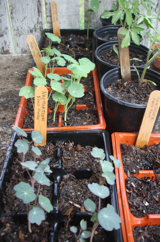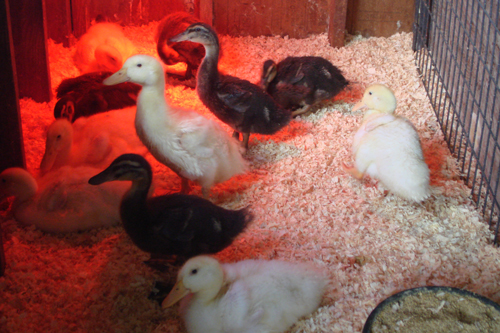Posts Tagged ‘Fruit Trees’
Sowing Seeds for Garden Success

In my neck of the woods, February and March are prime garden readiness months. Fruit trees are pruned, berries are trimmed of dead canes and tied to trellises or fencing, raised beds are restocked with compost or built brand new. But, the most fun of this time of year is starting seeds. We mark the day on our calendars and when it arrives the task begins like the start of an Olympic race.
There’s truly nothing better than plunging your hands deep into freshly dug soil, warmed by the spring sun and planting homegrown seedlings started way back in winter, when spring was just a hope and a dream. And, the money you save over buying already started veggies and the vibrant taste of homegrown food ain’t bad either.
This is also the time when garden centers and hardware stores stock a plethora of seed starting paraphernalia: peat pots, soil pellets, plastic pots, covered mini-greenhouses, you name it, if it can start a seed, some store in your area will carry it.
But, do you really need all this fancy commercial stuff to start the seeds you want to plant in your garden. The answer is no! Seeds are not divas. They don’t require 5-star accommodations to germinate and thrive. What they do require is the right kind of starter/growing medium, the right amount of moisture, warm temperatures and room to produce a strong healthy root system. Read the rest of the story »
Taking Back Life
Taking back a life and a farm is no easy task. It starts early, lasts till dark and cleanses the body with sweat. My “take back” plan started in the quiet pre-dawn hours of the morning. Over a cup of free trade tea I sat at my kitchen table staring out the window and thinking as all that needed to be done rumbled through my head. But none of that would get the job done, so I picked up my pen and started writing, making a list really of all the chores, repairs, tasks, errands that needed to be accomplished to get us back on track.
When I had filled an entire page I stopped, a little overwhelmed by the shear volume. But when I realized the jobs were falling into categories like barn, garden, yard, garage, house I felt a little better. I could group the jobs by area and work on one area at a time with inside jobs being done in the middle of the day when it was too hot outside to work very long in the garden or yard.
By mid-morning I had fed and collected eggs, planted and watered in 45 4” pots of pumpkins, squash, and tomatoes, watered 2 flats of sunflower seedlings, picked lettuce, radishes and spinach, fixed the water line to the fruit trees, repaired a few sprinklers, washed and refilled water fonts, water buckets and water bottles, scrubbed out and stored the water fonts used for the meat ducks, swept the front of the barn of cobwebs and dirt, cleaned the kitchen and thrown in two loads of laundry. I didn’t work at a frantic pace, I’ve had enough of that lately, but I worked steadily, moving seamlessly from one task to another like a dance of persistence and determination. As each chore was marked off the list I could feel the chaos and stress fade in my body and my mind.
A short break and a much needed glass of Mason Jar tea gave me time to regroup, figure out my next step and, of course, add to the list. The sun was reaching high in a crystal blue sky and it was getting warmer, no sign of the storm reported on last night’s news. Some of our chores would need supplies which meant a trip into town. We were also low on chicken and sheep feed and I had a few errands to run too, so I decided this would be our afternoon break with lunch thrown in as a treat.
I love living in a small town. I never have to go very far for the things I need. Some people think it’s boring, no energy and nothing to do, but there’s a different kind of energy in a small town. It’s steady and constant. I like it.
When I had unloaded 300 pounds of livestock feed and put away the proceeds of my errands I set about repairing a water hose blown out during the duck butchering. Nothing goes to waste on a small farm, if it can be repaired.
The worked continued…mow the lawn, clean the rabbit hutch, refill nesting boxes with bedding, bolt together another raised bed and fill it with cleanings from the barn and coop along with a healthy dose of garden soil and compost, a new home for salad greens and root vegetables. As later afternoon came we began to wind down. A late afternoon snack and drink, and a call from my sister inviting me to the movies brought our day’s work to an abrupt end. So much had been done and life was beginning to look normal again. After a quick shower and a change of clothes I’m off to see “The Best Exotic Marigold Hotel”. I think I deserve it.
Besides, as Scarlett O’Hara famously said, “tomorrow is another day”.
This weekend marks the official start to our growing season

and so it begins…
It the middle of February, technically still the dead of winter, but our unseasonably mild winter has every gardener itching to get outside and into the dirt. This weekend marks the official start to our growing season for cool weather crops, but we’ve had lettuces and spinach in the patio pot garden for weeks and they are now ready to harvest. Seems odd to be eating fresh greens this time of year when root crops and squash are the mainstay of any menu.
Seeds of other cool season crops and ones I know I want to grow are planted in pony-packs, peat pellets and flats and are incubating inside the farmhouse. Tomatoes, broccoli, cauliflower, cabbage, bell peppers and cucumbers are sitting inside on warming mats and in a few days we’ll have the beginnings of a summer full of fresh organic food.
The farm already has a huge garden complete with compost pile, raised beds, fencing for vine crops, berry patch, fruit trees, a chicken coop and a rain collection barrel. Whoever lived here before had no interest in living a sustainable life or even gardening for that matter. It has taken me years to clear out the debris, trim or remove overgrown and useless trees and rejuvenate the soil to the point where it could sustain life. But, we did it. The soil is rich and friable, crawling with earthworms in every spade that is turned. This is a huge accomplishment – soil that is alive!!
In a few weeks the soil will be over 45 degrees; dry enough that I can till and work in the mulch and compost that was laid on top during the winter months; warm enough to plant the first seedlings outdoors. I’m excited. Along with the seedlings, root vegetables like beets, carrots, radishes and turnips will be directly sown. Read the rest of the story »
Gratitude for Blessings Not Yet Seen
I spent quite a bit of time on my garden rearranging project this past weekend. There’s still a lot left to do, but I did manage to move the berry bed to the north side of the garden, digging up and moving some of the blackberry, boysenberry and Fall Gold raspberry canes. The rest of the canes were planted in a large black tub to winter over. In the early spring, when it’s time to plant I’ll repot them for my front porch farmer’s market or the sale my garden club has each year.
The fruit trees were pruned and given 2 pounds each of gypsum. I spread it around the canopy line and gently scratched it into the soil. Sunday’s steady rain storm will push the nutrients down to the roots to feed them all through the winter.
Our big storm slated to arrive on Saturday evening finally blew in on Sunday and should last for several days. I raked leaves and dug them into the new raised vegetable beds, a foundation of organic matter. Some were piled over the perennial bulbs for protection.
By Saturday afternoon, the only task left to do was to dig up and separate my collection of Iris bulbs. Admittedly this is coming late in the season, but in Southern California Irises can be planted or divided any time of year with great success. Last months hot east winds had battered the Iris foliage, turning it dry and brown; very unsightly. Read the rest of the story »

 We’ve had a busy week so far and tonight was the first time it seemed like we could relax a bit while going about the nightly chores. It was nice outside. We’ve had a strange winter of fluctuating temperatures, rain and wind storms. One day its cold and winter like, the next the thermometer shoots up to 70 and somewhere in between the winds from the east start to howl. My poor fruit trees don’t know whether to flower or go dormant and a few bulbs are already pushing their heads up out of the ground.
We’ve had a busy week so far and tonight was the first time it seemed like we could relax a bit while going about the nightly chores. It was nice outside. We’ve had a strange winter of fluctuating temperatures, rain and wind storms. One day its cold and winter like, the next the thermometer shoots up to 70 and somewhere in between the winds from the east start to howl. My poor fruit trees don’t know whether to flower or go dormant and a few bulbs are already pushing their heads up out of the ground.




Recent comments
Aenean nonummy hendrerit mauris. Phasellus porta.